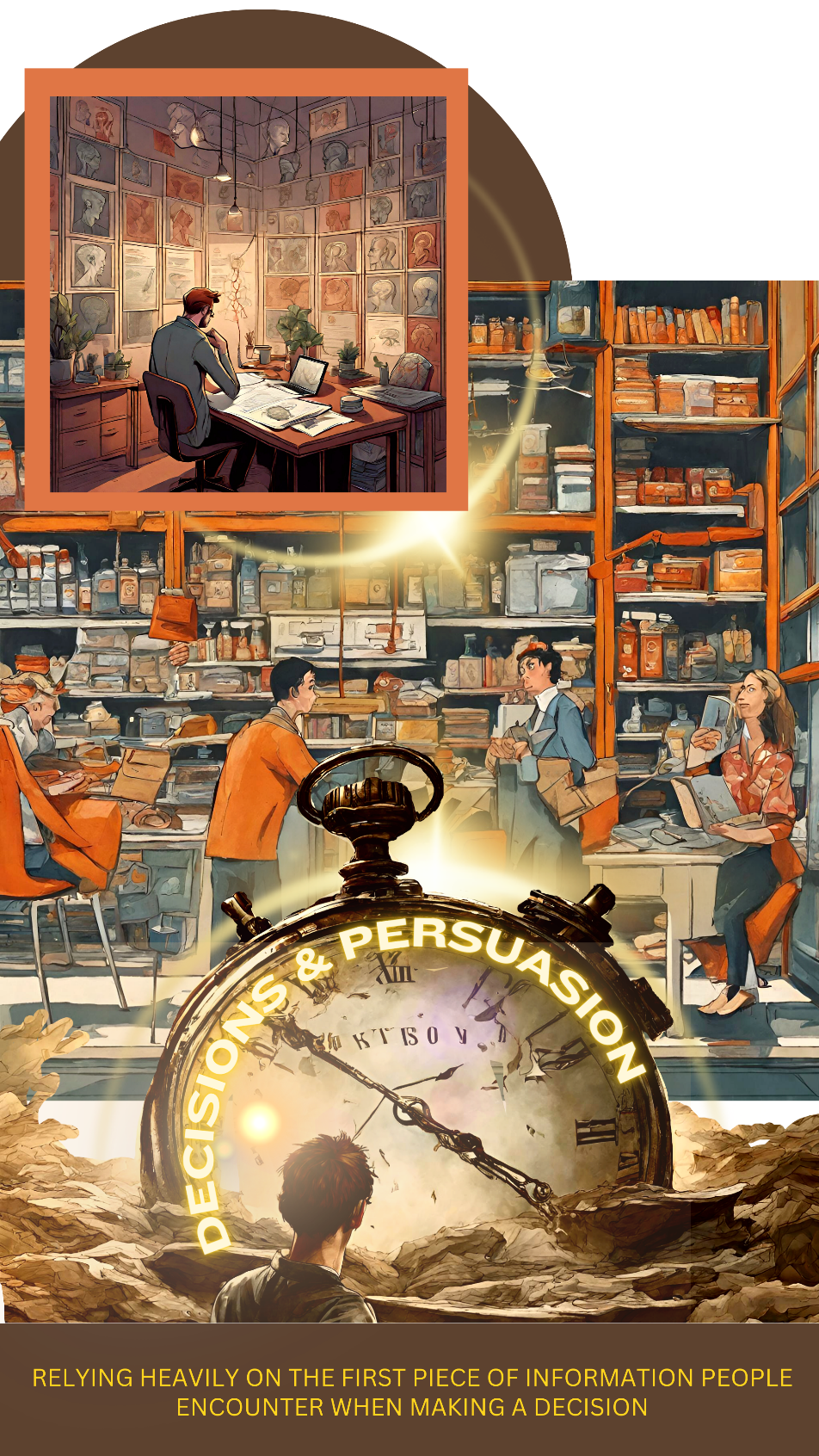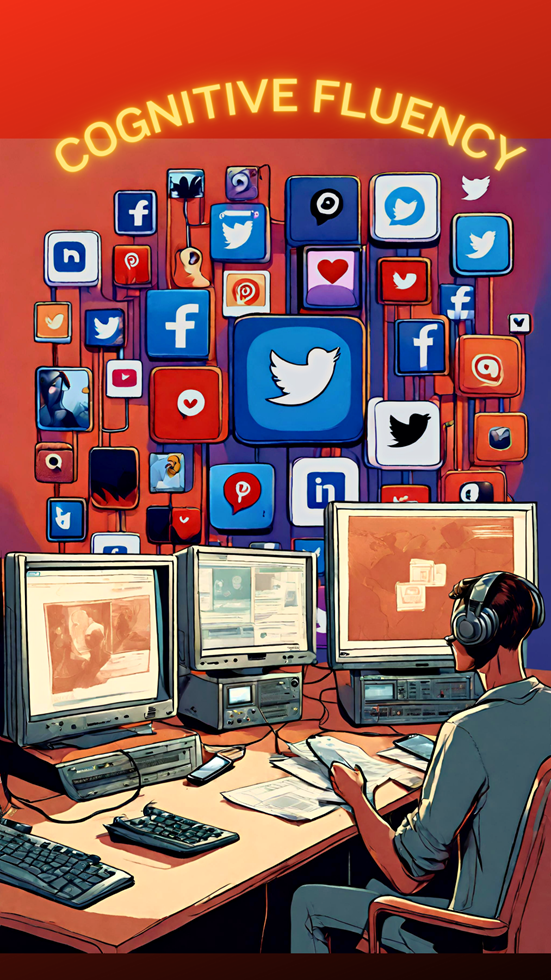
Remembering for Recall
To the Reader: In this white paper series, we unveil the secrets held at the intersection of three pillars of professional expertise, revealing a roadmap for those who aspire to excel in the ever-evolving field of marketing and communication. Welcome to a world where expertise is the ultimate currency, and Multimedia Marketing Group is your trusted guide on this transformative journey. The series embarks on an expedition through the realms of cognitive psychology, the 10,000-hour concept, and the unique role of Marketing Diagnostic Experts. These three pillars intersect to unveil the intricate interplay between science and intuition in advertising, marketing, and communication. This document is divided into three distinct chapters, each shedding light on a fundamental aspect of this journey.
Chapter 2
Memory is a fundamental aspect of cognitive psychology that has profound implications for marketing and communication. How do people remember and forget information? What makes a brand or a message memorable?
One of the most essential principles in this domain is the “spacing effect.” Cognitive psychology has shown that information is better retained when it’s presented and reviewed over spaced intervals rather than forcing content all at once. Marketers use this concept when planning their advertising campaigns. Instead of bombarding consumers with repeated ads in a short time, they spread out the messages to increase the likelihood of recall.
Then there’s the idea of primacy and recency effects. These psychological phenomena suggest that people tend to remember the first and last pieces of information in a series more vividly. In marketing and advertising, this translates to the importance of making a strong first impression and leaving a memorable closing statement. Think about the opening jingle of a famous commercial or the catchy slogan that’s repeated at the end.
The “spacing effect” is a well-documented cognitive phenomenon that plays a crucial role in learning, memory, and information retention. This principle suggests that information is better retained when it’s presented and reviewed over spaced intervals rather than being crammed or repeatedly reviewed in a short time frame. Let’s explore the spacing effect in more detail:
How the Spacing Effect Works:
- Distributed Practice: The spacing effect is closely related to the concept of distributed practice or spaced repetition. Instead of studying or reviewing material in one large block (massed practice), the spacing effect recommends distributing these study or review sessions over time. For example, if you’re learning a new language, you might review vocabulary words on different days over several weeks rather than trying to learn all the words in one marathon session.
- Improved Retention: The spacing effect is rooted in the idea that our memory benefits from the intervals between learning or reviewing. When we space out our learning, it allows our brains to forget some of the material between sessions. While this might sound counterintuitive, the process of forgetting and then relearning strengthens memory recall. The spaced repetition effectively strengthens memory traces, making the information more durable and accessible.
- Memory Retrieval: Spaced repetition taps into the psychological principle of retrieval practice, which involves actively recalling information from memory during each review session. This act of retrieval helps reinforce memory and retrieval pathways, making it easier to recall information later.
Applications of the Spacing Effect:
- Education: The spacing effect is widely used in educational settings to enhance learning and retention. For instance, educators often encourage students to review and study course material incrementally throughout the semester rather than cramming right before exams. The use of flashcards and online tools that employ spaced repetition algorithms has become popular for language learning and memorization.
- Language Learning: Spaced repetition is particularly effective for language learning. Language learners can use specialized apps and software that use algorithms to determine when to review specific words and phrases to optimize retention.
- Employee Training: In corporate training and professional development, spaced repetition techniques are employed to ensure that employees retain and apply new knowledge and skills over time.
- Advertising and Marketing: In advertising and marketing, the spacing effect is also relevant. Advertisers may strategically space out their advertisements over time to reinforce their brand or message in consumers’ minds. This is often seen in ongoing, consistent advertising campaigns that aim to maintain brand awareness.
Challenges and Considerations:
While the spacing effect is a powerful tool for improving memory and learning, it’s essential to strike the right balance. Overdoing spaced repetition can lead to diminishing returns, as the intervals between reviews become too long. Additionally, the effectiveness of the spacing effect can vary based on individual differences and the complexity of the material being learned.
As you have seen, the spacing effect is a fundamental principle in cognitive psychology and education. By understanding and applying this principle, individuals who are perusing marketing and communication expertise, can optimize their learning and retention of information, leading to more effective and efficient learning experiences. This principle is not only relevant in marketing firm settings but also in various real-world applications, including in-house marketing and advertising, where it can be used to reinforce brand messages and enhance consumer retention.
Decisions and Persuasion
Persuasion
In marketing and communication, the ultimate goal is often to persuade people to take action. Whether it’s buying a product, supporting a cause, or signing up for a newsletter, understanding the cognitive processes behind decision-making is crucial.
Cognitive psychology introduces the notion of heuristics and cognitive biases. These are mental shortcuts and errors in thinking that influence how we make decisions. Marketers are well aware of these biases and use them to their advantage. For instance, the anchoring bias suggests that people tend to rely heavily on the first piece of information they encounter when making a decision. Knowing this, marketers often display a higher initial price, only to reveal a discounted price, making it seem like a great deal.
The mere-exposure effect is another cognitive phenomenon that plays a role in persuasion. It states that people tend to develop a preference for things they’re exposed to repeatedly. Marketers leverage this principle through repeated advertising, making their brand or message more familiar and likable.
Cognitive psychology explores the fascinating concepts of heuristics and cognitive biases, which are central to understanding how the human mind processes information and makes decisions.
- Heuristics:
Heuristics are mental shortcuts or rules of thumb that the human brain employs to simplify complex decision-making processes. They are cognitive strategies that allow individuals to quickly arrive at a solution or judgment without engaging in exhaustive analysis. Heuristics are generally helpful and efficient, as they save time and mental effort. However, they can sometimes lead to errors or biased decision-making due to their simplifying nature. Here are a few common heuristics:
- Availability Heuristic: This heuristic relies on the ease with which information comes to mind. If something is readily available in memory, people tend to overestimate its importance or frequency. For example, after hearing news about a recent plane crash, people may perceive air travel as riskier than it actually is because the tragic event is vivid in their minds.
- Representativeness Heuristic: This heuristic involves making judgments based on how closely an object or event resembles a prototype or stereotype. People may use this heuristic to categorize someone as a certain profession based on their appearance, even though it might not be an accurate judgment.
- Anchoring and Adjustment Heuristic: This heuristic involves starting with an initial estimate (the anchor) and then adjusting it based on new information. Anchoring can lead to biased judgments because people tend to insufficiently adjust from the initial anchor. For instance, in pricing negotiations, if one party starts with a high anchor price, it may influence the final price even if it’s not justified.
- Satisficing: Satisficing is a heuristic where individuals choose the first option that meets their minimal criteria, rather than thoroughly evaluating all available options. This approach may lead to suboptimal decisions but saves time and effort.
- Cognitive Biases:
Cognitive biases are systematic patterns of deviation from rationality or objective judgment in decision-making. These biases are a consequence of heuristics and other mental shortcuts, and they can influence perceptions, judgments, and decision-making processes. Here are some notable cognitive biases:
- Confirmation Bias: This bias involves the tendency to seek out and interpret information in a way that confirms preexisting beliefs or hypotheses, while ignoring or downplaying contradictory information. It can lead to a reinforcing of existing beliefs rather than objective evaluation.
- Overconfidence Bias: People often overestimate their own abilities, knowledge, or the accuracy of their beliefs and predictions. This can lead to risky decision-making or unwarranted confidence in one’s decisions.
- Hindsight Bias: Hindsight bias is the tendency to perceive events as having been more predictable after they have already occurred. People may believe that they “knew it all along” even if they had no such foresight.
- Anchoring Bias: As mentioned earlier, anchoring bias occurs when individuals rely too heavily on the first piece of information encountered (the “anchor”) when making decisions.
- Availability Cascade: This bias involves the self-reinforcing process of publicizing and repeating information or beliefs. When a particular idea or fact is repeated frequently, it becomes more accessible in memory, leading people to overestimate its importance or accuracy.
Implications for Marketing and Communication:
Heuristics and cognitive biases have significant implications for marketing and communication. Marketers often leverage these psychological tendencies to influence consumer behavior. For example:
- Scarcity Heuristic: Marketers can create a sense of urgency by implying that a product or offer is limited, which can prompt consumers to act quickly.
- Social Proof: Utilizing testimonials, user reviews, and showing that others have adopted a product or service can tap into the heuristic of social proof to influence decision-making.
- Anchoring and Adjustment: In pricing, setting a higher anchor price before revealing a discounted price can lead consumers to perceive the discount as more substantial.
- Framing Effect: The way information is presented (positive or negative framing) can influence decision-making. For example, as you have seen many times, a health product can be framed as “90% fat-free” or “10% fat.”
Understanding heuristics and cognitive biases is vital for marketers to create effective campaigns and engage with their target audience effectively. By aligning marketing strategies with these cognitive tendencies, marketers can better connect with consumers and optimize their messaging and offers.
Cognitive psychology for marketing and communication delves into the intricate processes involved in language understanding and production, shedding light on the mental mechanisms that enable humans to communicate effectively.
Language and Communication
Language is a central component of human cognition, and cognitive psychology delves into how we understand and produce language. In marketing and communication, language is the vessel through which messages are conveyed, making it a critical aspect to consider.
One of the key principles here is the concept of cognitive fluency. It’s the idea that people prefer information that is easy to process. Marketers strive for cognitive fluency by using clear and concise language. They avoid jargon and complexity, making it easier for consumers to understand and connect with the message.
Cognitive psychology explores how humans understand and produce language, shedding light on the intricate processes involved in linguistic comprehension and expression. This area of study delves into various aspects of language, including syntax, semantics, pragmatics, and psycholinguistics. Let’s expand on these concepts:
- Syntax:
Syntax refers to the rules and principles governing the structure of language. Cognitive psychology investigates how the human mind processes and understands sentence structure, word order, and grammatical rules. Researchers study how people parse sentences, identify subjects and objects, and interpret the relationships between words. Understanding syntax is essential for comprehending the meaning of sentences and effectively communicating through language.
- Semantics:
Semantics involves the study of word meaning and the interpretation of words and phrases. Cognitive psychology explores how individuals connect words to concepts and how they derive meaning from sentences. This field of marketing and communication examines how humans understand and use language to convey information, including the nuances of word meanings, idiomatic expressions, and figurative language (e.g., metaphors and similes).
- Pragmatics:
Pragmatics focuses on the social and contextual aspects of language use. It investigates how language is used to achieve specific communicative goals and how listeners or readers infer meaning from the context. Cognitive psychology examines how people interpret conversational implicatures, indirect speech acts, and the influence of shared knowledge and context on communication.
- Psycholinguistics:
Psycholinguistics is a subfield of cognitive psychology that explores the cognitive processes involved in language comprehension and production. It delves into the mental mechanisms that enable people to understand spoken and written language, as well as the processes involved in generating language when speaking or writing content for advertisements, media releases or branded media content. Psycholinguistics also investigates topics such as language acquisition, language disorders, and the relationship between language and thought.
Key Concepts in Understanding and Producing Language:
- Mental Lexicon: The mental lexicon is a mental repository of words and their associated meanings. Cognitive psychology examines how individuals’ access and retrieve words from their mental lexicon during language processing.
- Sentence Parsing: Cognitive psychology investigates how individuals parse sentences to identify syntactic structures, such as subjects, verbs, and objects. The parsing process helps in constructing a coherent understanding of sentences.
- Discourse Processing: This involves understanding the structure of conversations and texts, including how information is organized and linked across sentences and paragraphs.
- Language Production: Cognitive psychology examines the processes involved in planning and producing spoken and written language, from selecting words and constructing sentences to articulating speech and writing.
- Bilingualism and Multilingualism: The study of how individuals who speak multiple languages manage their languages, switch between them, and the impact of bilingualism on cognitive functions is another area of interest.
Applications:
Understanding how humans comprehend and produce language has significant practical applications, such as in the development of language-learning tools, natural language processing in technology, speech recognition, language therapy, and education. Additionally, insights from cognitive psychology contribute to our understanding of cognitive development, including how children acquire language and how language abilities change with age.
To summarize, cognitive psychology for marketing and communication delves into the intricate processes involved in language understanding and production, shedding light on the mental mechanisms that enable humans to communicate effectively. This understanding has broad implications for marketing professionals, digital technology specialists, and other media fields related to language and communication.

“In visual design, the layout, color schemes, and overall aesthetics can influence cognitive fluency. Metaphors are tools that help people make sense of complex or abstract ideas by relating them to something more concrete.”
Metaphors are another linguistic tool that cognitive psychology sheds light on. Metaphors enable marketers to convey complex ideas in a more digestible manner. For instance, “time is money” is a metaphor used by businesses to emphasize the importance of efficient time management.
Cognitive fluency and metaphors are linguistic tools rooted in cognitive psychology, each playing a significant role in how information is processed, understood, and remembered.
- Cognitive Fluency:
Cognitive fluency, also known as processing fluency, refers to the ease and speed with which the human mind processes information. It is an essential concept in cognitive psychology because it influences how people perceive, comprehend, and engage with messages, whether in written or visual form. Cognitive fluency can be affected by various factors, and it has several implications for communication and marketing:
- Clarity and Simplicity: Messages that are clear and straightforward are more cognitively fluent. When information is presented in an organized, easily digestible manner, people are more likely to understand and retain it. For example, a simple and concise product description is more likely to be remembered than a convoluted one.
- Repetition: Repeated exposure to the same information enhances cognitive fluency. This is why marketers often use slogans, jingles, or repetitive advertising messages. The more familiar something becomes, the easier it is to process and remember.
- Typography and Readability: Typography choices, such as using legible fonts and appropriate text size, can enhance cognitive fluency in written materials. The more comfortable text is to read, the better it’s understood.
- Visual Presentation: In visual design, the layout, color schemes, and overall aesthetics can influence cognitive fluency. A well-designed website, for instance, can provide an effortless browsing experience, contributing to cognitive fluency.
- Language Familiarity: Using language that the target audience is familiar with is essential for cognitive fluency. If the audience struggles to understand technical jargon or unfamiliar terminology, it hampers the flow of information.
- Consistency: Consistency in branding and messaging contributes to cognitive fluency. When visual elements and language are consistent across marketing materials, it makes it easier for consumers to recognize and connect with a brand.
Cognitive fluency is a valuable principle, as it facilitates the reception and retention of messages. When information is presented in a way that is easy to process, it enhances the overall effectiveness of advertising and communication efforts.
- Metaphors:
Metaphors are linguistic devices that enable individuals to understand one concept or experience in terms of another, often unrelated, concept or experience. Metaphors are powerful tools because they help people make sense of complex or abstract ideas by relating them to something more concrete and familiar. Here’s how metaphors work and their relevance in communication:
- Simplification: Metaphors simplify complex ideas. For example, describing a computer’s central processing unit (CPU) as the “brain” of the computer helps people grasp its role and importance, even if they don’t understand the technical details.
- Visualization: Metaphors create mental images that aid comprehension. When a teacher describes a challenging math problem as a “puzzle,” students may find it easier to visualize and solve.
- Emotion and Engagement: Metaphors can evoke emotions and create engagement. In advertising, metaphors can be used to convey a brand’s values or benefits by associating them with emotionally resonant concepts or images.
- Memorability: Memorable metaphors stick in people’s minds. A good metaphor can make a message more memorable and shareable. Think of Nike’s “Just Do It” slogan, which metaphorically encourages action and empowerment.
- Persuasion: Metaphors can be persuasive by framing a concept in a particular way. For example, a company might describe its eco-friendly practices as “planting the seeds of a sustainable future,” which portrays them as environmentally responsible.
- Cultural Relevance: Metaphors often draw on cultural references, making them relatable to a specific audience. This cultural relevance can create a sense of connection.
As you can see, metaphors are a valuable tool in communication and marketing. They enhance cognitive fluency by making complex concepts more accessible and memorable. They can also convey emotions, create engagement, and frame ideas persuasively. When used effectively, metaphors can help messages resonate with the target audience and foster a deeper understanding of the content.
This white paper is divided into four Chapters. Chapter three will focus on “Neuromarketing – The Mind’s Inner Sanctum”
Categories
Recent Posts
- Maximize Your Reach: Essential Email Marketing Dos and Don’ts for Success July 9, 2024
- Social Media Day 2024 June 30, 2024
- Navigating the World of Social Media Advertising June 20, 2024
- The Power of Visual Content in Marketing April 8, 2024
- Hip Hopper Alert: Easter Bunny Steals the Show with Sunglasses Stunt March 31, 2024
- The Super Bowl Ads 2024 February 12, 2024
- Serving Our Client’s Social Media Platforms Branded Content February 5, 2024
- Days of Future Past January 31, 2024
- The Art of Blending Human Intuition and Data-Driven Insights January 31, 2024
- Beyond Intuition January 30, 2024
Recent Comments